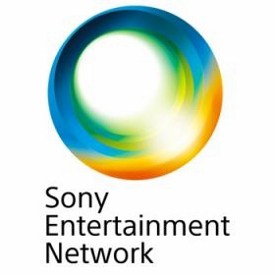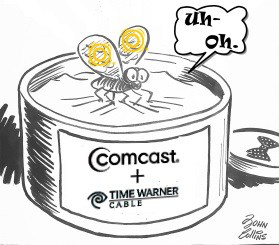Stop the Cap! completed and today filed a formal submission with the Federal Communications Commission opposing the merger of Time Warner Cable and Comcast.
We joined tens of thousands of filers — mostly consumers — strongly opposed to the merger on the grounds it is not in the public interest.
Earlier today, Consumers Union filed its petition with more than 20,000 signatures of ordinary Americans across the United States who want nothing to do with Comcast.
Back here in New York, Comcast this afternoon filed a response with the Public Service Commission regarding our (and other) submissions opposed to the merger. We will be analyzing and rebutting their response straight away. Comcast went all-out name-dropping people and groups (many with direct, usually undisclosed financial ties to Comcast) to sell New York regulators the theory ‘the groups and people who matter’ are in favor of their merger while those opposed are mostly out-of-state rabble or unsubstantial individuals of few words.
“Given these many concrete benefits, and the lack of any harm to competition or consumers, it should come as no surprise that the overwhelming majority of the substantive comments (approximately 110 out of a total of about 140 substantive comments) filed in this proceeding support Commission approval of the transaction,” writes Comcast.
Comcast did not share their subjective standard of what constitutes “substantive” but a quick review of the groups cited in Comcast’s response show some substantive was involved – a check from Comcast either recently or in the past. Our view is that it doesn’t take more than a sentence to express extreme displeasure about Comcast taking over Time Warner Cable, and those views should matter just as much as a virtual Hallmark card from a group or politician that used a Comcast-provided “template” with a detachable check at the bottom.
Our favorite was Comcast’s highly defensive ‘hey New York PSC, it’s none of your business that Comcast is testing usage caps and you cannot use it against us’:
The Writers Guild of America, West, Inc. (“WGAW”), Zephyr Teachout and Tim Wu, and Stop the Cap! argue that Comcast will extend data caps and usage-based pricing to New York to impose restraints on online content and drive up consumer costs.
This broadband-related claim is irrelevant to this proceeding and beyond the Commission’s jurisdiction. Indeed, the FCC expressly approved of usage-based billing in its 2010 Open Internet Order and is again examining the issue in the pending Open Internet rulemaking.
In other words, whether data caps are appropriate is a matter of federal regulatory concern, not one that relates to this proceeding or that is even transaction specific (since nothing precludes TWC from adopting caps at any time, as it has in the past).
So regardless of whether data caps are in the public interest or not, New York should not be allowed to weigh in because former FCC chairman Julius Genachowski said usage based billing could be an innovative way to bill for broadband.
In reality, New York can decide for itself what is in the best interests of its residents, and Time Warner Cable determined what was best after a two-week firestorm in 2009 that taught them compulsory usage caps were a really bad idea. But Comcast isn’t terribly interested in the views of the unsubstantive masses — which is comparable to their attitude toward customers, so no change there. It’s just a free preview weekend of what we all have in store if Comcast takes over.


 Subscribe
Subscribe Late last week, hundreds of thousands of PlayStation Network users subscribed to Time Warner Cable broadband found their game play interrupted
Late last week, hundreds of thousands of PlayStation Network users subscribed to Time Warner Cable broadband found their game play interrupted  Although Charter Communications did not succeed in its bid to assume control of Time Warner Cable, it isn’t crying about its loss to Comcast either.
Although Charter Communications did not succeed in its bid to assume control of Time Warner Cable, it isn’t crying about its loss to Comcast either.
 The federal government is likely to count Bright House’s 2.2 million customers as part of the Time Warner Cable family, at least as far as control of cable programming pricing is concerned. Despite Comcast’s voluntary commitment to keep its national share of the cable TV business under 30 percent with the merger of Time Warner, Comcast hasn’t taken seriously counting the customers of the uninvited cousin – Bright House.
The federal government is likely to count Bright House’s 2.2 million customers as part of the Time Warner Cable family, at least as far as control of cable programming pricing is concerned. Despite Comcast’s voluntary commitment to keep its national share of the cable TV business under 30 percent with the merger of Time Warner, Comcast hasn’t taken seriously counting the customers of the uninvited cousin – Bright House.
 Connecticut’s Attorney General has announced a deal with Frontier Communications to approve its acquisition of AT&T’s wired assets in the state. The office asked for and got a three-year rate freeze on basic residential telephone rates and a commitment to keep selling standalone broadband at or below Frontier’s current rates. Low-income military veterans would receive basic broadband service for $19.99 per month, a substantial discount off the regular price of $34.99. The first month of service is free.
Connecticut’s Attorney General has announced a deal with Frontier Communications to approve its acquisition of AT&T’s wired assets in the state. The office asked for and got a three-year rate freeze on basic residential telephone rates and a commitment to keep selling standalone broadband at or below Frontier’s current rates. Low-income military veterans would receive basic broadband service for $19.99 per month, a substantial discount off the regular price of $34.99. The first month of service is free.